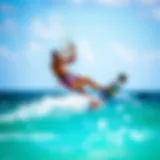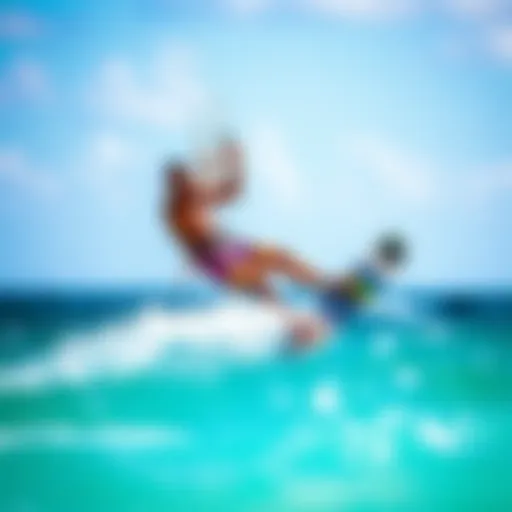Guide to Choosing Used Kite Equipment
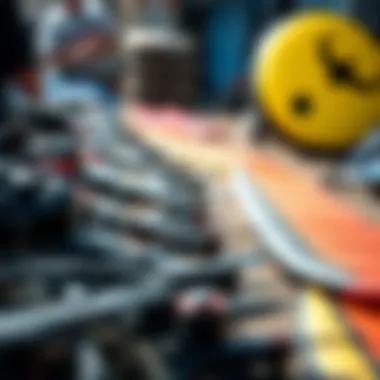
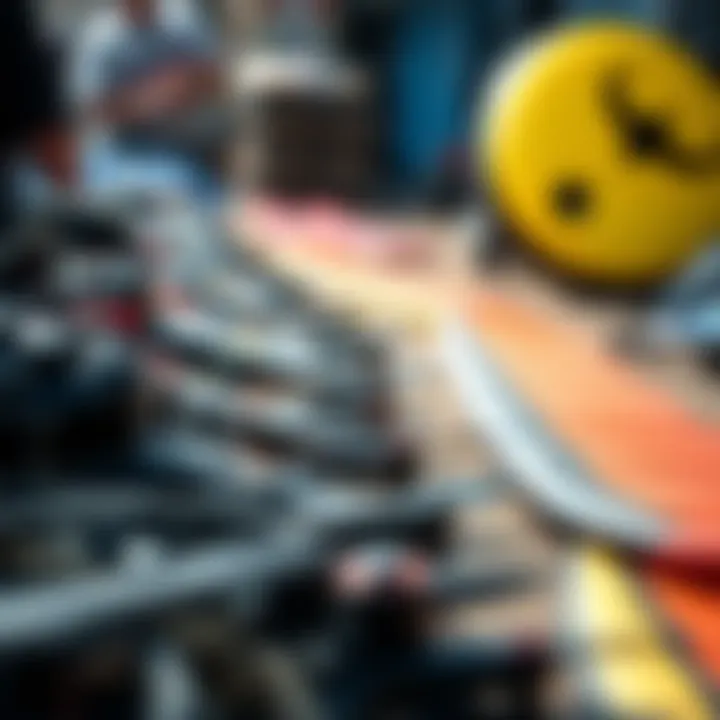
Intro
Kiteboarding has gained momentum, not only as a thrilling sport but also as a lifestyle choice that resonates with many. Amidst the vast expanse of the ocean and the rush of the wind, aspiring kiteboarders often contemplate their gear. In this pursuit, the used kite equipment market stands out, allowing both novices and skilled riders to make savvy purchases while ensuring affordability and sustainability.
With the rise of second-hand gear, it’s essential to grasp the intricacies involved in selecting, maintaining, and understanding the environmental implications that come along with used kite equipment. Whether you’re a seasoned kiteboarder looking to save a few bucks or just entering the world of flying kites, this guide aims to equip you with the knowledge necessary. Let’s delve into the ins-and-outs of picking the right gear while considering its impact on our wallet and the planet.
Gear Selection
Selecting kiteboarding equipment can feel like navigating a maze, but figuring out what you need doesn’t have to be daunting. Ultimately, the decision boils down to personal preference and riding style, but understanding your options can make all the difference.
Types of Kites
When it comes to kites, you'll encounter different types tailored for distinct conditions and styles. Below are some key variations:
- Foil Kites: Lightweight and efficient, good for light winds.
- LEI (Leading Edge Inflatable) Kites: The most common type for recreational kiteboarding.
- Delta Kites: Known for their versatility in wide wind ranges, suitable for beginners.
While you browse through used kites, don’t shy away from examining the fabric and seams. Checking for repairs is a must; sometimes a bit of patching tells a story of adventure, resilience, and a promising ride ahead.
Choosing the Right Board
Just as vital as the kite itself, the board plays an integral role in your kiteboarding experience. There are various shapes and sizes, impacting how the board performs. Here are some points to consider when selecting a second-hand board:
- Board Size: Select according to your weight and skill level; bigger boards offer stability.
- Materials: Look for boards made from durable materials that can withstand scrapes and bumps.
- Fin Configuration: The options here affect grip and control; more fins may offer better stability.
Before sealing the deal, take a moment to think about how the board feels under your feet. If it feels comfortable, then you may have found your match.
"The right equipment will elevate your kiteboarding experience, letting you ride the waves with confidence."
Ensure you conduct a thorough inspection, noting any signs of wear or damage, as these factors can influence your performance.
Skill Development
Even with the finest equipment, mastering the art of kiteboarding demands practice and patience. Here’s how to enhance your skills strategically.
Essential Techniques
- Body Positioning: Maintain a balanced stance to ensure you’re stable while riding.
- Kite Control: Learn to steer your kite smoothly, responding to the wind’s shifts without overcorrecting.
- Board Riding: Focus on soft landings and gradual acceleration, keeping your knees bent to absorb shocks.
Progression Tips
Advance your skills progressively, setting tangible goals. Start by practicing on less windy days and gradually incorporate more wind challenges as you build confidence.
Additionally, consider engaging with local kiteboarding communities, either online or in person, to exchange insights and learn from experienced riders.
For further information and resources about used kite equipment, feel free to check out Wikipedia or visit forums on Reddit.
Dive deep into the world of kiteboarding, and make each ride a memorable one!
Intro to Used Kite Equipment
The realm of kiteboarding can often feel like a whirlwind of excitement mingled with the burden of investment. Buying new equipment can be quite a costly venture, especially for those just dipping their toes into the sport. This is where used kite equipment comes into play, offering both new and seasoned kiteboarders options that are not only budget-friendly but teeming with potential savings. When venturing into the realm of used gear, it's crucial to understand what makes it appealing and the dynamics at play in this marketplace.
Understanding the Appeal of Used Gear
Diving into used kite equipment means navigating a sizable market filled with varied offerings. The appeal lies not just in the price but also in the chance to own quality gear that has a story behind it. This previous ownership often comes with a level of authenticity that new gear may lack — each kite, board, or harness having seen its fair share of waves and winds. For many, buying used isn’t just a frugal choice; it feels like embracing the spirit of the sport itself — a community where experience and legacy are shared through the equipment.
Advantages of Purchasing Used Kite Equipment
Cost Efficiency
Cost efficiency is a big draw for those considering used equipment. The idea of saving money makes it an attractive option for budding kiteboarders who might not be ready to fork out serious cash. On average, used kite gear can be found at prices up to fifty percent lower than new items. This significant difference allows kiteboarders to acquire quality gear without breaking the bank. With this financial flexibility, enthusiasts can invest more in lessons or even travel to kiteboarding hotspots.
Moreover, many users are keen to upgrade their equipment frequently. Consequently, items that are just a season old can sometimes still be in excellent condition but sold for much less than their original price. This corner of the market is brimming with great deals.
Key Benefits of Cost Efficiency:
- Budget-Friendly: Allows for a wider array of options within a limited budget.
- Upgrading Opportunities: Allows potential buyers to experiment with different kinds of equipment.
Sustainability Considerations
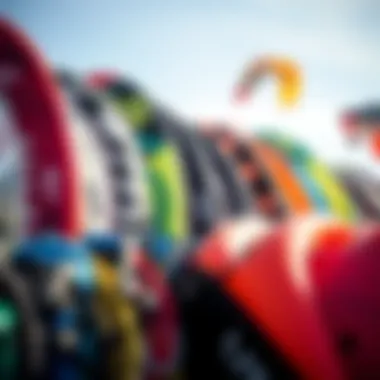
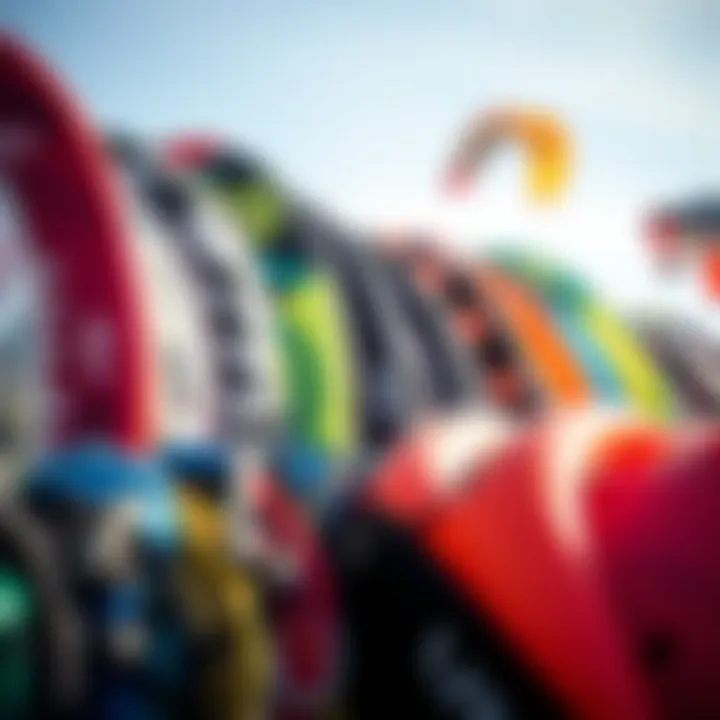
In a world increasingly aware of environmental implications, purchasing used kite equipment offers a hitch-free path for sustainability. Each piece of used gear represents a step away from waste. The less we resort to manufacturing new equipment, the less strain we place on our planet, making second-hand equipment an eco-friendly choice. Buying used means fewer resources expended on production and transportation.
Another facet of sustainability is promoting a circular economy, where gear can change hands multiple times, prolonging its life cycle. This not only serves the environment but also builds community ties among kiteboarders who are increasingly recognizing the value in sharing experiences through their gear.
Key Points about Sustainability:
- Waste Reduction: Minimizing waste by extending the lifecycle of kite equipment.
- Community Building: Strengthening relationships among kiteboarders through shared resources.
In summary, used kite equipment opens doors to both cost saving opportunities and a sustainable practice that readers of this article can greatly benefit from. In the following sections, we will delve deeper into the various types of used gear available and the crucial criteria to consider when making your selection.
Types of Used Kite Equipment
Understanding the types of used kite equipment is essential for any kiteboarder looking to make informed purchases and enhance their performance on the water. It is not merely about finding a bargain; it’s about matching the equipment with personal riding style, skill level, and the specific conditions one expects to encounter. Getting the right gear can lead to a more enjoyable and safe experience, reducing frustration and promoting growth in this exhilarating sport.
Kites
Different Kites for Various Conditions
When it comes to kiteboarding, the condition of the wind plays a vital role in one's experience. Different kites are tailored for various wind strengths and riding styles. For instance, a larger kite is typically better for light winds, while smaller kites are ideal for strong winds. This distinction helps riders maximize their performance.
A kite like the Epic Kite's Renegade is known for its versatility across wind conditions, making it a favorite among intermediate to advanced riders. On the flip side, a kite such as the Naish Pivot excels in high wind situations, which can be a game changer for those in gusty areas. Understanding these characteristics allows riders to better prepare for their next adventure.
Key Features to Look For
When evaluating kites, several key features can significantly affect your experience. One of the most important characteristics is the aspect ratio. A higher aspect ratio typically translates to better performance in terms of speed and lift, while a lower aspect ratio offers improved stability and usability in tricky conditions. The briddle setup is also worth noting; it impacts the way your kite flies, particularly in terms of responsiveness and ease of use.
Ultimately, considering these features attentively can greatly influence not just your purchase decision but also your overall riding experience.
Boards
Sizing and Performance Aspects
The right board size can make all the difference. A larger board often provides better buoyancy and stability, making it a fantastic choice for beginners or those riding in lighter winds. In contrast, a smaller board allows for quicker turns and maneuverability, appealing to advanced riders who enjoy pushing their limits.
A board such as the Cabrinha Spectrum is often praised for its versatility and is an excellent pick for diverse conditions, aligning well with different rider preferences. Understanding the sizing and how it correlates with your intended use is vital for optimizing your time on the water.
Material Variations
Material choices can elevate or limit your experience. For example, boards made from carbon fiber tend to be lightweight yet incredibly stiff, providing better pop for jumps and tricks. On the other hand, traditional fiberglass boards offer more flex and comfort for learning and cruising, which can appeal to those who prefer a more forgiving ride.
Selecting a board based on its material can guide you in achieving a balance between performance and comfort. Knowledge about these variations empowers kiteboarders to invest wisely in quality used equipment.
Harnesses and Lines
Safety and Security Features
Investing in a harness with good safety features is not negotiable. Many modern harnesses include integrated safety release systems, allowing for quick detachment in emergencies. A secure harness will feel comfortable yet snug, ensuring it doesn’t slip or cause discomfort while riding.
Harnesses like the Mystic Warrior are often recognized for their robust build and favorable safety features, making them reliable choices for riders who prioritize safety above all. Noticing how these features contribute to overall security can help riders feel confident when tackling challenging maneuvers.
Wear and Tear Indicators
It's crucial to assess the condition of harnesses and lines before purchasing. Indicators of wear and tear such as frayed webbing, discoloration, or broken buckles can signal that equipment might fail under pressure. A harness should fit comfortably with no signs of stretching or structural crippling. Lines should be checked for any UV damage or excessive wear that could compromise performance.
Knowing what to look for in terms of wear and tear can ultimately save a rider from making a costly mistake.
"Investing time to understand these aspects of used kite equipment can elevate your experience, making for a safer, more enjoyable ride."
Overall, diving into the types of used kite equipment with diligence opens the door to informed choices. It's not merely about getting the gear at a cheaper price; it involves choosing equipment that complements your journey, ensuring an exhilarating experience every time you hit the water.
Criteria for Selecting Used Kite Equipment
Choosing used kite equipment isn’t just about saving a few bucks or being eco-friendly. It involves a thoughtful examination to ensure that you’re investing in gear that meets your needs and safety requirements. Good criteria help inform decisions, enhancing both enjoyment and safety on the water. Investing time in this selection process pays off, ensuring that your kiteboarding experience remains thrilling yet secure.
Condition Assessment
Understanding the condition of used kite equipment is the first step in ensuring that it's the right choice for you. It’s akin to finding a hidden gem in a sea of old stones. A thorough assessment helps spot potential issues that might turn a fun day on the water into a huge disappointment.
Visual Inspections
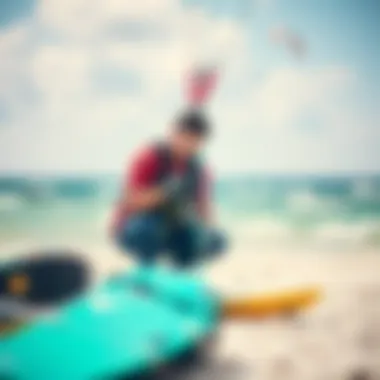
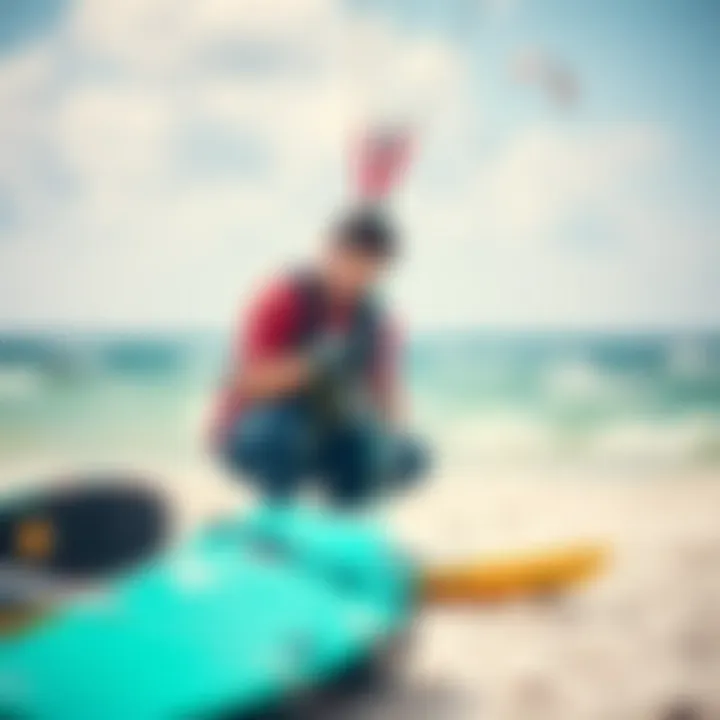
Visual inspections serve as your first line of defense in evaluating used gear. You’re not just looking for scratches or tears; you’re examining the entire piece for any signs of damage, wear, or neglect. A kite, for instance, with frayed lines or discolored fabric can indicate extensive prior use, or worse, compromise your safety.
A key characteristic of visual inspections is their immediacy. You can perform them quickly before deciding to delve deeper. This allows you to weed out questionable items right off the bat. A unique feature of visual inspections is that they often highlight superficial damage, easily overlooked by the inexperienced eye.
Advantages of this approach include immediacy and simplicity, but beware—some issues, like internal damage to a kite’s bladder, won’t be visible until it’s too late. So, while a quick visual check is beneficial, it shouldn’t be the only method employed when assessing equipment.
Functional Testing
Functional testing goes hand in hand with visual inspections to ensure that used kite equipment is not just pretty on the outside. This process involves actually putting the equipment through its paces. You might inflate a kite to check for leaks or rig up a board to see how well it engages in controlled conditions.
The key characteristic of functional testing is its ability to expose hidden faults that aren’t evident from mere observation. It’s not enough for a kite to look good; it must perform well too. Functional testing stands out because it offers practical insight into how the equipment would respond during actual use.
One major advantage is the assurance of performance reliability, while the downside might be the requirement of specific conditions or settings to truly assess the gear effectively. Without this kind of testing, you could be buying a ticket to disappointment when you hit the water.
Brand Reputation
The brand of your used kite equipment can have a serious impact on its quality and performance. Recognizing which brands stand the test of time—those synonymous with reliability and durability—is essential for making a sound investment. This aspect provides insight into the craftsmanship behind each piece of equipment.
Trusted Manufacturers
With kiteboarding gear, not all brands hold the same weight. Trusted manufacturers have established a reputation through consistency in performance, safety, and innovation. They often provide superior materials, design choices, and warranties, giving you confidence in your purchase.
What sets these manufacturers apart is their commitment to quality and customer support. Features associated with trusted brands usually include durable materials and positive feedback from the community. However, sticking strictly to big-name brands may limit options in the second-hand market, requiring compromises in cost or features.
Advantages include a better chance of avoiding faulty equipment, while disadvantages might be limited variety and higher prices due to brand prestige.
Product Reviews and Recommendations
In this digital age, product reviews and recommendations are like guiding stars amidst a bewildering sea. They offer a glimpse into the experiences of others who have tread the path you’re about to embark on. Reviews provide insights into performance longevity, comfort, and even customer service quality.
A crucial aspect of reviews is their collective nature; multiple opinions offer a balanced view that reduces risk when buying used gear. They are popular among savvy kiteboarders looking to gauge both satisfaction and potential drawbacks. Unique features include the ability to explore feedback from various platforms, such as forums, specialized kiteboarding sites, or even social media groups.
One advantage is that it can help you uncover hidden issues before they become your problems. Still, one must weed through subjective opinions—the fervor of individual experiences can sometimes muddy the waters of judgment. Balancing professional reviews against user feedback is key to arriving at a well-rounded conclusion.
Market Trends for Used Kite Equipment
As more people delve into kiteboarding, understanding the market trends around used kite equipment becomes essential. The landscape of second-hand gear is evolving, influenced by factors like consumer behavior, environmental awareness, and the rapid advancements in technology. By keeping an eye on these trends, potential buyers and sellers can make informed choices that align not just with their budget but also with their values.
Online Platforms for Buying and Selling
Marketplace Websites
Marketplace websites have transformed the way kite enthusiasts buy and sell used equipment. Websites like eBay and Facebook Marketplace serve as digital hubs where sellers can showcase their gear to a wider audience. Typically user-friendly, these platforms allow for easy navigation, making it simple for users to filter listings based on brand, condition, and price. Sellers benefit from the broad exposure these platforms offer, attracting a diverse group of potential buyers.
One significant aspect of marketplace websites is the ability to communicate directly with sellers. This fosters transparency, as buyers can ask specific questions about the gear's history, condition, and performance. Furthermore, these platforms often integrate user review systems, allowing buyers to gauge the credibility of sellers based on previous transactions. However, it’s important to remain cautious of certain challenges, including potential scams or misrepresented items, which may dampen the advantageous experience.
Local Classifieds
Local classifieds serve as another valuable resource for those looking to buy or sell used kite equipment. Traditional platforms such as Craigslist or local Facebook groups often connect buyers and sellers within the same community, promoting face-to-face transactions. The immediacy of localized selling not only enhances trust but also allows buyers to inspect the equipment in person before making a purchase.
One of the appealing characteristics of classifieds is the potential for negotiation. Buyers can haggle, which can lead to better deals—especially if the seller is motivated to sell quickly. However, this approach can sometimes lead to inflated prices if sellers perceive a lack of knowledge from buyers. Even so, engaging with local classifieds can open opportunities to unearth rare finds or unique deals that may not be available online.
Seasonal Variations in Pricing
Peak Buying Seasons
Seasonal trends can play a significant role in the pricing of used kite equipment. Often, peak buying seasons align with the beginning of kiteboarding seasons, typically in spring and summer, when interest in the sport surges. Sellers can take advantage of this phenomenon as demand drives prices up, creating an opportunity for those looking to sell their gear at higher rates.
Additionally, being aware of these seasonal shifts can help buyers time their purchases effectively. By tracking seasonal trends, enthusiasts can identify when prices may drop post-season, leading to more favorable buying conditions. This awareness is an asset for those who might be flexible with their timing.
Discount Periods
Discount periods, on the other hand, represent golden opportunities for bargains. These periods often coincide with end-of-season sales or clearance events, where both retailers and individual sellers look to offload excess inventory or older models to make way for new arrivals. During these windows, buyers are likely to encounter marked-down prices and potentially find high-quality gear at fractions of original costs.
However, it’s vital for buyers to approach these opportunities with due diligence. While a lower price can be enticing, ensuring that the quality and functionality of the equipment meet safety standards is essential. Likewise, timing is a crucial factor, as these opportunities are often ephemeral and can vanish quickly.
Maintenance of Used Kite Equipment
Maintaining used kite equipment isn't just a matter of keeping things looking shiny and new; it plays a pivotal role in ensuring longevity, performance, and safety during kiteboarding adventures. By understanding maintenance protocols, kiteboarders can enhance the lifespan of their gear, reduce unexpected failures, and ultimately enjoy a better experience on the water. When it comes to used gear, proper maintenance takes center stage as previous wear may pose risks if not addressed correctly.


Cleaning and Care Practices
Materials-Specific Cleaning Techniques
Cleaning your kite equipment according to its material characteristics can make a world of difference. For instance, kites made of ripstop nylon require gentle cleaning to avoid compromising the integrity of the fabric. Using warm water and mild soap on such materials ensures that dirt and salt aren't just wiped away, but without harming the fibers.
On the flip side, boards often have different cleaning needs; for example, epoxy boards benefit from a rinsing with fresh water to remove saltwater residues, preventing oxidation and degradation. This materials-specific approach not only contributes to the longevity of the gear but also keeps it performing at an optimal level. In this article, understanding the cleaning techniques specific to various materials can be immensely beneficial for kiteboarders striving for efficiency. However, keep in mind that some cleaning agents might be harsh, thus always opt for those that are known to be safe for the material.
Storage Recommendations
Storing your used kite equipment properly is just as crucial as cleaning it. Keeping kites and boards in a cool, dry environment protects them from extreme temperatures and humidity which can warp materials and fade colors. A unique feature to consider is how kites often come with their own travel bags; these bags are designed to offer additional protection against physical damage and environmental elements.
Moreover, if you plan to store kites for long periods, it’s advisable to loosen the straps to avoid stressing the fabric. While proper storage may seem like a hassle, it is a wise investment in preserving the equipment’s usability and performance. Forgetting this aspect often leads to unnecessary repairs, which can be costly and time-consuming.
Repair and Restoration
Common Repairs
Even the best-maintained used kite equipment can run into trouble sooner or later. Common repairs include patching small holes in kites or re-knotting frayed lines. These repairs are vital to keeping your gear functional without having to purchase new equipment often. A notable point is that many local shops offer repair services, and some even hold repair workshops for enthusiasts looking to hone their skills. Here’s the kicker: regular maintenance checks can often identify issues before they escalate, saving both time and money in the long run. This proactive approach encourages kiteboarders to engage more deeply with their gear and understand its intricacies.
When to Consult a Professional
Knowing when to seek help from professionals can save kiteboarders a lot of heartache. If you encounter structural damage or complex repairs that you feel uncomfortable addressing on your own, consultation becomes essential. Professional services not only ensure that repairs are done accurately, but they can also provide insights into preventing future issues. The reality is, tackling major repairs without sufficient expertise could lead to greater problems down the line, affecting both your safety and the equipment's functionality.
Environmental Implications of Used Kite Equipment
The environmental impact of used kite equipment is a topic that cannot be ignored. As kiteboarding continues to grow in popularity, understanding the footprint of our gear becomes essential. Purchasing used gear not only reflects a desire to save money but also shows a commitment to sustainability. When riders opt for second-hand equipment, they contribute to a significant reduction in waste, prolonging the life cycle of products and reducing the demand for new materials.
Waste Reduction and Recycling
Second-Hand Market Impact
The second-hand market plays a crucial role in the kiteboarding ecosystem. When someone decides to sell their used gear, it creates a pathway for new enthusiasts to enter the sport without shelling out top dollar for brand-new equipment. This market fosters a sense of community among kiteboarders, as sharing resources and experiences can lead to a more informed user base.
Moreover, when kites, boards, and harnesses find new homes, we reduce landfill contributions. Instead of tossing old gear, sellers extend its life and keep it from becoming waste. However, this benefit comes with a flip side; buyers should be cautious about purchasing equipment with hidden damages. Overall, the second-hand market is a beneficial choice for newcomers and seasoned riders alike, offering both affordability and eco-friendliness.
Eco-Friendly Disposal Methods
When it comes to disposing of old kite equipment, environmentally friendly methods are essential. Not every piece of gear can simply be thrown away; many materials used in kiteboarding, like nylon and PVC, can take hundreds of years to break down. Recycling helps mitigate this issue, allowing components like cloth and plastic to be reused for other purposes. Many organizations focus on recycling kite materials into products like bags or even art installations.
Another great approach is donating usable gear. Local schools or community centers may appreciate receiving the equipment for educational purposes or rental programs. Yet, if disposal is the only option, a careful approach is necessary to ensure that components are recycled correctly. While this eco-friendly choice contributes to sustainability, it requires awareness and diligence on the part of the owner to follow through properly.
Sustainable Practices in Kiteboarding
Using Durable Materials
Opting for durable materials is essential in the kiteboarding world, where wear and tear can easily take a toll on gear. Brands are increasingly sourcing materials specifically designed for longevity, such as high-tenacity fabrics and reinforced stitching. These advancements not only enhance performance but also mean riders won't have to replace equipment as frequently, ultimately reducing waste. When investing in gear, choosing products made from sustainable materials like recycled plastics not only performs well but supports a healthier planet. This strategy not just reflects a smart purchase but is gradually becoming a norm in the kiteboarding community.
Promoting Responsible Usage
Responsible usage is an attitude that every kiteboarder should adopt. Treating equipment with care—be it through regular maintenance or mindful storage—can significantly extend its lifespan. Furthermore, sharing best practices within the community is key. Events like local workshops or group rides can foster discussions about caring for equipment properly, emphasizing that thoughtful usage is a cornerstone of sustainability. Promoting responsible usage cultivates a culture where riders are encouraged to think long-term about gear choices, leading to wider acceptance that sustainability within the sport is both possible and necessary. As kiteboarders, our practices shape the future of the sport and our environment.
The choices we make today regarding our gear will shape the kiteboarding landscape of tomorrow. Together, we can promote a better world.
Culmination and Future Considerations
In the world of kiteboarding, the conversation around used equipment is evolving at a rapid clip. With shifts in market dynamics and environmental consciousness, kite enthusiasts are increasingly turning to second-hand gear not just as a budget-friendly option, but as a deliberate choice toward sustainable practices. This conclusion encapsulates the essence of why understanding the landscape of used kite equipment is paramount for both new and experienced riders.
The Evolving Landscape of Kite Equipment
The kiteboarding industry is not static. In fact, it's a live wire, constantly buzzing with innovations in technology and shifts in consumer preferences. There's a growing inclination towards eco-friendliness, prompting manufacturers to reassess their production methods and encouraging consumers to look for sustainable choices.
Just a few years back, used gear was often perceived as lesser quality, but this viewpoint has shifted. Nowadays, many brands have sturdy warranties, and the availability of a thriving secondary market has bolstered confidence in pre-owned kites, boards, and accessories. The rise of social media platforms and dedicated forums means you can now easily tap into a community that shares insights and experiences, helping you gauge what to look for in used equipment before making a purchase.
"Purchasing used kite equipment isn't just about saving a buck; it’s about making a statement for responsible consumption."
This developing attitude not only enriches the buyer’s experience but also reflects a larger trend towards a circular economy. As production processes get scrutinized, you begin to notice brands that commit to recycling materials or offer take-back programs, thereby further promoting the secondary market.
Final Thoughts on Choosing Used Gear
Navigating the used equipment market can feel like standing on shifting sands—uncertain and somewhat daunting. However, with some groundwork and an informed approach, the potential for great finds is immense. Some pointers to consider when making your choices include:
- Do Your Homework: Research the specific types of kites and boards best suited for your riding style. Knowing your needs helps in identifying the right gear, even if it's marked 'used'.
- Condition is King: Always prioritize the condition of the equipment. A used kite might look pristine, but it's essential to delve deeper. Understand the wear and tear indicators specific to kites, boards, and harnesses.
- Trust Your Sources: Buy from reputable platforms, be it online marketplaces or community swap meets. The recommendations of fellow riders can make or break your acquisition.
- Don’t Go Alone: If possible, bring a buddy who’s savvy in kiteboarding to help you evaluate potential purchases. Two sets of eyes can catch what one might miss.
Selecting used gear can be a strategic move to not only save money but to also dive into an experience that’s richer in community ties and sustainability. As the kiteboarding community continues to embrace this trend, transitioning to used gear presents both a cost-effective and environmentally friendly approach that holds promise for the future.
This reflects an intricate dialogue between our enjoyment of the sport and our stewardship of the environment. With careful attention to selection criteria and a willingness to engage with the vibrant community of kiteboarders, every decision leads to waves of possibilities.












